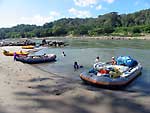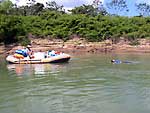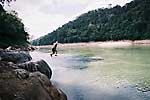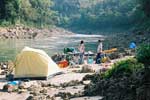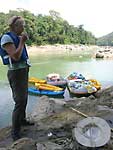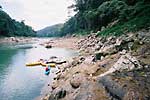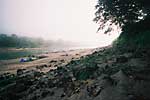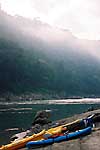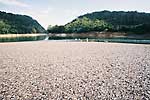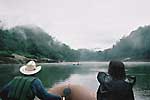On the River
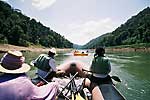 We were ten people - five men and five women. We had one fiberglass kayak
brought by its owner, three inflatable kayaks called duckies and two 8-man
(or larger) rafts. All our equipment was carried in the larger raft which
was piloted by Steve, our fearless leader and
We were ten people - five men and five women. We had one fiberglass kayak
brought by its owner, three inflatable kayaks called duckies and two 8-man
(or larger) rafts. All our equipment was carried in the larger raft which
was piloted by Steve, our fearless leader and 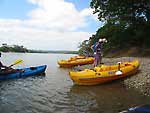 organizer.
It was the most stable and least likely to capsize in the rapids. Mostly
we floated with the currents but we did encounter some rapids almost daily.
They mostly added to the excitement and Steve's emphasis on safety as
we approached them, made it all very dramatic. Safety in general was the
order of the day.
organizer.
It was the most stable and least likely to capsize in the rapids. Mostly
we floated with the currents but we did encounter some rapids almost daily.
They mostly added to the excitement and Steve's emphasis on safety as
we approached them, made it all very dramatic. Safety in general was the
order of the day.
whirlpools were not uncommon since the course of the river is not very
even. They would sometimes spin your boat around in a complete circle.
Very entertaining and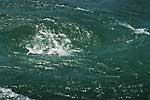 thrilling except in the rapids where they can be larger than the rafts
themselves. Fortunately there were no major capsizes where someone is
sucked under by one but a few of the duckies got a good dousing. The rafts
would often take on water. Sorry, there are no photos of the rapids since
all equipment was stowed to avoid loss in case of a spill. Maybe next
year.
thrilling except in the rapids where they can be larger than the rafts
themselves. Fortunately there were no major capsizes where someone is
sucked under by one but a few of the duckies got a good dousing. The rafts
would often take on water. Sorry, there are no photos of the rapids since
all equipment was stowed to avoid loss in case of a spill. Maybe next
year.
At the end of the day, Steve would select a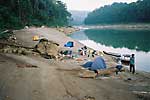 beach on which to camp. The river is alive and constantly changing, so
last year's beaches were very different or disappeared altogether and
there were new beaches were none existed before. The fact that there were
beaches at all was due to the low level of the water. It rains
beach on which to camp. The river is alive and constantly changing, so
last year's beaches were very different or disappeared altogether and
there were new beaches were none existed before. The fact that there were
beaches at all was due to the low level of the water. It rains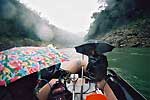 in the Lacandon eight months of the year - four meters (156 inches) on
average. It had not rained much since December and so the river was roughly
ten meters (32.5 feet) or more below the "tree line" or its
normal, rainy season level creating those beaches and also the rapids.
Of our ten days on the river, we had one morning of light rain. Curiously,
the rain showed us just how warm the river really is. During the day a
quick dip in the river was refreshingly cool. After being rained on for
three hours, the river water seemed warmer, more like bathwater.
in the Lacandon eight months of the year - four meters (156 inches) on
average. It had not rained much since December and so the river was roughly
ten meters (32.5 feet) or more below the "tree line" or its
normal, rainy season level creating those beaches and also the rapids.
Of our ten days on the river, we had one morning of light rain. Curiously,
the rain showed us just how warm the river really is. During the day a
quick dip in the river was refreshingly cool. After being rained on for
three hours, the river water seemed warmer, more like bathwater.
We stopped often enough to cool off by jumping in the river. The water is not crystal clear but naturally very clean with only rainforest debris such as leaves and sand and soil. The Lacandon is, to say the least, sparsely populated. We didn't see too many people . We pretty much has the river to ourselves.
Meals were a communal affair. Cathy, who lives in Palenque and was on the trip before, did most of the cooking, but everybody helped out in one way or another. Cathy, by the way, is an excellent cook but be advised, if you have no business there, stay out of her kitchen. The food was great and plentiful. Nobody went hungry. Sometimes we stopped for lunch, sometimes we ate on the run, or should I say, on the float. We passed things from one boat to another or tied up together riding on the current.
We had a couple of non-travel days. We would rest or read. Some of the
group went exploring on the edge of the river and found artifacts with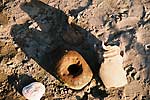 unknown pedigrees but considering the extent of the human occupation of
the region over various eras, it's not unlikely that they were very old.
We of course did not take them with us. One in particular seemed to prove
that the Maya drank coffee with donuts. We found what was clearly a petrified
honey glazed amongst the rocks, wedged there no doubt for eons. It did
seem that the glazing had been washed off during that time, though.
unknown pedigrees but considering the extent of the human occupation of
the region over various eras, it's not unlikely that they were very old.
We of course did not take them with us. One in particular seemed to prove
that the Maya drank coffee with donuts. We found what was clearly a petrified
honey glazed amongst the rocks, wedged there no doubt for eons. It did
seem that the glazing had been washed off during that time, though.
At night the sky was generally clear and the first few nights we had the benefit of a full moon. Its reflection sparkled on the river and, deep in the jungle with no ambient lighting, it illuminated our campsite. The height of the tree canopy and the surrounding hills prevented seeing too many stars before moonrise. But so many of the constellations seemed not to be in their proper locations. The overall direction of the river is northeast, emptying into the Gulf of Mexico. At this stretch, however, the river flows in a northwesterly direction for many miles. It is for this reason the stars appeared out of whack. Some of us should have checked the maps before we put-in.
One daily occurrence, quite unusual, was the Howler
Monkeys 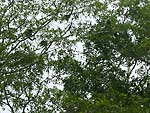 that,
well, howled all night and a good part of the day. As common as they are,
they are hard to photograph since they live at the very tops of the trees.
Sometimes whole families would be above us, watching us when we spent
the day at one beach or other. We were as grand a curiosity to them as
they were to us. But at night, they seemed at times to be eerily just
outside our tents... howling, of course.
that,
well, howled all night and a good part of the day. As common as they are,
they are hard to photograph since they live at the very tops of the trees.
Sometimes whole families would be above us, watching us when we spent
the day at one beach or other. We were as grand a curiosity to them as
they were to us. But at night, they seemed at times to be eerily just
outside our tents... howling, of course.
There wasn't too much wildlife immediately present as were the monkeys. It was, afterall, winter. There were some vultures, hawks and eagles easily, though rarely spotted. There were many smaller birds, flying in flocks, but because they were flying above the forest canopy, generally 120 feet (38 meters) above the forest floor, they were difficult to identify. They seemed to be mostly green parrots.
Most of the animals, particularly the birds, were heard more than seen. Nights were generally pretty noisy affairs with various frogs, insects and, of course, the monkeys.
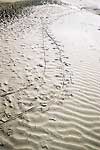 We
were fortunate to see three crocodiles along the banks. One was some two
meters (6.5 feet) in length. Once spotted, we spent the rest of the trip
looking for more but to no avail. Sorry, no photos though. Iguana were
plentiful and one beach had the largest frogs I had ever seen. Walking
with a flashlight, you would come across one and be startled. The curious
thing was, even with a light shined on them, they do not move. It was
as though they were statues of frogs rather than the real thing.
We
were fortunate to see three crocodiles along the banks. One was some two
meters (6.5 feet) in length. Once spotted, we spent the rest of the trip
looking for more but to no avail. Sorry, no photos though. Iguana were
plentiful and one beach had the largest frogs I had ever seen. Walking
with a flashlight, you would come across one and be startled. The curious
thing was, even with a light shined on them, they do not move. It was
as though they were statues of frogs rather than the real thing.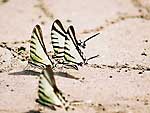
What was plentiful were butterflies of various designs and color schemes, leading you to wonder what they must be like in the summertime. Oddly, they would congregate in large groups around a particular point at river's edge. We surmised that perhaps it was a salt deposit or animal urine that attracted them.
There were some flowers in bloom but plenty of evidence of orchids, though sadly they were not yet in bloom. we were told that in June and July the forest explodes in cascades of color. It would be nice to return some day to see it.
Mornings were misty, even sometimes foggy, but would clear as the sun rose. It did provide numerous opportunities for photographs.
We arrived for lunch on day two at Chicozapote Falls.
